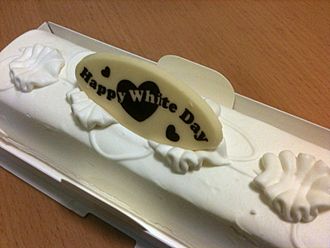White Day facts for kids
Quick facts for kids White Day |
|
|---|---|

White Day cake
|
|
| Observed by | Countries in East and Southeast Asia |
| Date | March 14 |
| Next time | 14 March 2025 |
| Frequency | Annual |
| Related to | Valentine's Day |
| White Day | |||||||
|---|---|---|---|---|---|---|---|
| White Day | |||||||
| Chinese name | |||||||
| Traditional Chinese | 白色情人節 | ||||||
| Simplified Chinese | 白色情人节 | ||||||
|
|||||||
| Burmese name | |||||||
| Burmese | အဖြူနေ့ | ||||||
| Vietnamese name | |||||||
| Vietnamese | Ngày Valentine Trắng | ||||||
| Korean name | |||||||
| Hangul | 화이트데이 | ||||||
|
|||||||
| Japanese name | |||||||
| Katakana | ホワイトデー | ||||||
|
|||||||
White Day is celebrated annually on March 14, one month after Valentine's Day, when people give reciprocal gifts to those who gave them gifts received on Valentine's Day. It began in Japan in 1978; since then, its observance has spread to several other Asian nations.
Origin
Though Valentine's Day was first attempted to be celebrated in Japan in 1936, it did not begin to be popularly celebrated until the 1970s, giving the day a different observation than in the West. It was primarily an opportunity for girls to show that they like a boy. In 1977, a Fukuoka-based confectionery company, Ishimuramanseido, marketed marshmallows to men on March 14, calling it Marshmallow Day (マシュマロデー, Mashumaro Dē). White Day was first celebrated in 1978 in Japan. It was started by the National Confectionery Industry Association as an "answer day" to Valentine's Day on the grounds that men should pay back the women who gave them chocolate and other gifts on Valentine's Day.
Soon thereafter, confectionery companies began marketing white chocolate. Now, men give both white and dark chocolate, as well as other edible and non-edible gifts, such as jewelry or objects of sentimental value, or white clothing like lingerie, to women from whom they received chocolate on Valentine's Day one month earlier. Flowers and other gifts are also given on this day.
Observation
White Day is celebrated one month after Valentine's Day, on March 14. In countries which observe White Day, typically Valentine's Day is celebrated by women and girls presenting chocolate gifts (either store-bought or handmade), usually to the other men and boys, as an expression of love, courtesy, or social obligation.
On White Day, the reverse happens: men who received a honmei-choco (本命チョコ, 'chocolate of love') or giri-choco (義理チョコ, 'courtesy chocolate') on Valentine's Day are expected to return the favor by giving gifts to the women. Gift exchanges happen between romantic partners, friends, and coworkers. Traditionally, popular White Day gifts include food like white chocolate, marshmallows, candy, and cookies, and other "white" accessories like jewelry, bags, lotions, and lingerie. Nowadays, gifts do not have to be white.
Sometimes the term sanbai gaeshi (三倍返し, 'triple the return') is used to describe the generally recited rule for men that the return gift should be two to three times the worth of the Valentine's gift they received.
In the latter half of the 2010s, sales figures indicated a decline in popularity of the observation. It was seen as a result from the reduction of sales of obligation chocolates on Valentines Day. Another reason given for the reduction of popularity is the changing gender roles within Japanese culture.
International observation
Outside of Japan, the practice of giving response gifts one month after Valentines Day has spread internationally. In those cultures, White Day is for the most part observed in a similar manner. Some places where this occurs include China, South Korea, Taiwan, and Vietnam.
See also
 In Spanish: Día blanco para niños
In Spanish: Día blanco para niños

